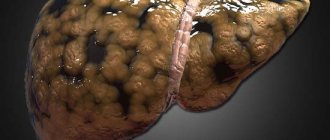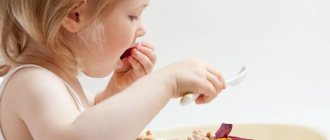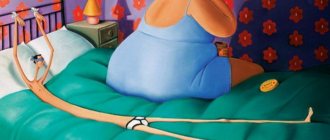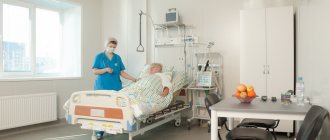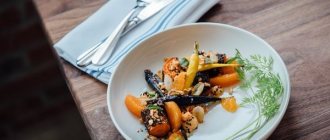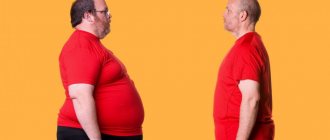Diarrhea or simply diarrhea is one of the many and very common signs of intestinal disorder. In adults, it is expressed by the presence of frequent (more than three times per day) and loose stools. Diarrhea is not a disease, but a symptom, and therefore quite often manifests itself in parallel with vomiting and elevated body temperature.
There are many causes of intestinal upset, but the main one is infection. Harmful bacteria enter the body of an adult through dirty hands, poorly washed vegetables and fruits, and due to the consumption of contaminated water.
During the period when diarrhea develops, the body intensively fights the pathogens of intestinal disease that have entered it and is very depleted. is of particular importance for a speedy recovery from diarrhea in an adult . A lighter type of nutrition removes a significant part of the burden of digesting and assimilating foods from disease-depleted organs.
Causes of diarrhea
The cause of diarrhea is always a dysfunction of the intestines, which can be caused by various factors. The formation of feces of liquid consistency is realized through the following mechanisms:
- increasing the speed of movement of processed food through the large intestine;
- reducing the degree of absorption of water and electrolytes in the colon;
- increased secretion of water and sodium ions in the intestines;
- increased formation of mucus in the intestines.
Most cases of diarrhea are caused by food or drink poisoning, or viral or bacterial infections. When pathogens of intestinal infection enter the body, the patient, in addition to diarrhea, also experiences high fever and vomiting. In this case, to prevent severe consequences, it is necessary to begin complex treatment as early as possible, which necessarily includes following a diet for diarrhea.
Hand washing before eating and proper food handling reduces the likelihood of intestinal pathogens entering the body
In addition, the causes of diarrhea may be:
- nervous stress;
- intoxication;
- taking medications (laxatives, antibiotics, cytostatics, etc.);
- dysbacteriosis;
- helminthic infestations;
- allergic reactions;
- intestinal diseases (ulcerative colitis, Crohn's disease, enterocolitis, enteritis, etc.);
- neoplasms, polyps or diverticula in the intestine.
Useful article? Share the link on VKontakte
Important: Assessing the frequency of stool, its color, smell, consistency, and the presence of impurities in it provides important information about the state of the digestive organs and helps the doctor determine the cause of diarrhea.
What examinations need to be done (diagnosis)
The first step to making a diagnosis is a thorough history. It is important to collect an epidemiological history, including information about recent travel.
Staying in the tropics significantly expands the list of diseases for differential diagnosis, but does not allow us to exclude common etiologies. Thus, bloody diarrhea after traveling to Africa is most likely caused by ulcerative colitis rather than amoebic dysentery.
Physical examination:
During a physical examination, additional clues are often found to determine the cause of diarrhea. If postoperative scars (surgical cause of diarrhea), increased peristalsis (auscultation), pain on palpation (infection and inflammation), space-occupying lesions are detected, a rectal examination and fecal occult blood test .
Fistulas in the anal area are characteristic of Crohn's disease. During sigmoidoscopy, ulcers or fecal impaction can be detected; the latter symptom is a common cause of pseudodiarrhea or paradoxical diarrhea.
Laboratory examination:
Basic laboratory examination includes a complete blood count with ESR, determination of the level of albumin, liver enzymes, thyroid-stimulating hormone and electrolytes.
A stool pH test is quickly performed in an outpatient setting if the patient is not taking medications. Collect at least 0.5 ml of stool, touch it with a paper nitrazine strip and compare the resulting color with the scale. If the pH is less than 5.5, this indicates increased acidity, which is characteristic of lactose intolerance.
To differentiate between secretory and osmotic diarrhea, the level of electrolytes in the stool can be determined. Although tests such as fecal pH and electrolyte levels have significant diagnostic value, they are often not ordered during the initial evaluation.
Pathological results of laboratory examination make it possible to differentiate an organic disease from a functional one.
If after travel the epidemiological history is difficult, a stool culture with an antibiogram , a test for worm eggs and parasites, and determination of Giardia and Cryptosporidium antigens in stool are indicated. Giardia and Cryptosporidium are often not detected during routine stool test for worm eggs, although Cryptosporidium can be diagnosed using acid staining.
Ultimately, a sigmoidoscopy or colonoscopy . The diagnosis of microscopic colitis can only be confirmed with an intestinal biopsy. If it is necessary to differentiate secretory diarrhea from another type of diarrhea, then collect feces per day for quantitative assessment.
Nutrition for diarrhea
The main goal of a diet for diarrhea in adults and children is to temporarily reduce the food load on the body and gradually restore normal bowel function. Recommended:
- stick to fractional meals (eat often, but in small portions);
- exclude foods that irritate the intestinal mucosa and cause increased gas formation;
- slightly reduce the amount of fats and carbohydrates, while the daily energy value of food entering the body should remain within normal limits;
- eat dishes prepared only by steaming or boiling, not containing any spices and seasonings;
- exclude products that have a choleretic effect;
- eat food in a warm state with a semi-liquid or mushy consistency to avoid mechanical and thermal irritation of the intestinal walls.
In addition to nutrition during diarrhea, due attention should be paid to the drinking regime. Special rehydrating solutions (Regidron, Gastrolit), powders for the preparation of which can be purchased at any pharmacy, still mineral water, black tea with lemon, herbal teas, apple juice, blueberry or rose hip decoction, will be very useful.
Important: Diarrhea, especially in combination with vomiting, in the absence of replenishment of lost fluid, can quickly lead to dehydration. This primarily applies to children and elderly people.
Authorized Products
Proper nutrition for diarrhea in adults and children helps the weakened body recover faster and improve the patient’s well-being in the first days. The most severe restrictions for intestinal upset are required on the first day. If a person has no appetite at this time, you should not try to force yourself to eat; you can limit yourself to drinking liquid. After each bowel movement, you need to drink at least 200 ml of liquid, preferably still mineral water or rehydration solutions.
What can you eat if you have diarrhea during the acute period? The list of permitted products includes:
- steam omelette;
- rice soup or congee;
- white bread crackers;
- well-cooked porridges cooked in water (buckwheat, semolina, rice, oatmeal);
- applesauce, jelly, compotes and jelly from non-acidic fruits and berries.
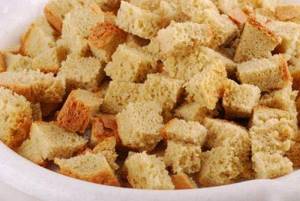
Rusks made from white or bran bread are a dietary product approved for use during diarrhea.
On the second and third days after diarrhea, fish and meat dishes and low-fat broths based on them are introduced into the menu. They can be consumed boiled or in the form of steam cutlets. Fresh low-fat cottage cheese and hard-boiled eggs are also allowed. Eating foods containing a lot of protein will help compensate for the protein lost by the body during diarrhea. Only salt is allowed to be used as a seasoning when preparing dishes, since it has the property of retaining water in the body, which is necessary to maintain normal water balance during diarrhea.
What can you eat if you have diarrhea in the following days? Gradually, vegetables and greens are included in the diet. They can be added to lean soups with well-cooked cereals. You should start with potatoes, carrots, zucchini, cauliflower. Potassium-rich bananas, potatoes, fruit juices, and baked apples must be present in the diet, since diarrhea causes the body to lose significant amounts of this element.
Recommendation: You can gradually return to your normal diet 7 days after diarrhea, while you need to carefully monitor your body's reaction and well-being.
Many people are interested in the question: is it possible to drink kefir if you have diarrhea? This fermented milk product certainly has a positive effect on the gastrointestinal tract and helps normalize the microflora. However, for diarrhea, it is used only after frequent loose stools have stopped.
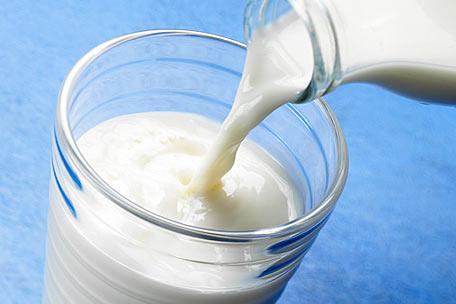
Kefir should not be consumed during diarrhea, as it increases intestinal motility
What can you eat after the diarrhea stops and the condition stabilizes? For one or two weeks after diarrhea, a person is recommended to adhere to therapeutic diet No. 4. This will help to effectively improve the functioning of the digestive tract and prevent possible digestive disorders when the intestines are weakened due to illness. The goal of the diet is to minimize fermentation and irritation in the colon. The total calorie content of foods consumed per day should be 2000 kcal, while the norm for protein is 90 g, carbohydrates - 250 g, fat - 70 g.
Prohibited Products
What should you not eat if you have diarrhea? The list of foods prohibited for diarrhea is very extensive. This includes any food that can cause bloating, irritation of the intestinal walls and thereby increase the duration of intestinal distress. At the same time, not only the qualitative composition of the diet, but also the form in which it is consumed is of great importance. For example, too hot or cold dishes, even if they are prepared from foods allowed for diarrhea, will increase intestinal motility. It is necessary to take into account that the reaction to a particular product may differ from person to person, therefore, when creating a menu for diarrhea, one must take into account not only general advice, but also individual characteristics.
For diarrhea it is not recommended to use:
- fried and fatty foods (meat, fish, vegetables);
- offal;
- white cabbage in any form, legumes, beets, turnips, cucumbers, radishes;
- smoked meats, canned food, pickles, semi-finished products;
- sweets and drinks containing caffeine;
- sparkling water;
- whole milk, heavy cream;
- spices, including horseradish, mustard, vinegar;
- sour fruits and berries, especially raw;
- brown bread, confectionery and rich bakery products;
- nuts;
- mushrooms.
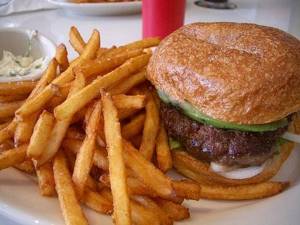
Any fried foods are strictly contraindicated for diarrhea
Important: If the treatment and diet for diarrhea does not bring relief within a few days, you should consult a doctor. The reason to immediately call medical help for diarrhea is high fever, vomiting, severe abdominal pain, and the presence of blood in the stool.
Allowed food
Despite the frustration, there is no need to refuse food at all. Doctors say that nutrition for diarrhea should be good and provide the body with the necessary microelements. Below is a table of what you can eat if you have diarrhea.
| Products for diarrhea | How to cook | Note |
| Cereals | In the form of side dishes, porridge exclusively on water | Barley is excluded |
| Lean meats | Boiling, steaming, casserole, soufflé | Do not eat lean meat with skins and films |
| “Skinny” varieties of sea fish | Boiling, steaming, baking, steamed cutlets | |
| Eggs | Soft-boiled | One egg a day. If the gastrointestinal tract reacts negatively, the product is excluded |
| Pasta | Boiled small vermicelli | Allowed no more than once a day |
| Milk | Add in minimal quantities to food when cooking | |
| Dairy products | Sour milk rich in bifidobacteria is beneficial | Allowed no more than once a day |
| Bread | Dried white bread, crackers | |
| Fruits and berries | Fresh raspberries, bananas, strawberries. Jelly, jelly, mousse | Eat one banana or baked apple as a snack |
| Vegetables | Baked in the oven, boiled, steamed | It is forbidden to eat onions and garlic |
This is not all that you can eat with diarrhea. Diet for diarrhea should be varied, include new foods in the menu, you should somewhat limit the consumption of fats and carbohydrates, but they cannot be completely excluded. The following foods are suitable for normalizing digestion:
- rich in pectin: baked apples, applesauce, bananas;
- rice porridge cooked in water without milk;
- foods rich in potassium: bananas, jacket potatoes;
- food rich in proteins: chicken breast, boiled veal, turkey.
The diet for diarrhea in an adult corresponds to dietary table No. 4.
Patients doubt what they can eat if they have poisoning and diarrhea. The actual question is whether you can drink milk. There is no categorical ban on milk, but for the first two days it is better to completely abandon it. You can later add milk when cooking.
Features of nutrition of children with diarrhea
When treating diarrhea in young children, the participation of a doctor is necessary. A child becomes dehydrated much faster than an adult, which poses a serious threat to the baby's health. A doctor should give information about what you can feed a child with diarrhea after determining the cause of this condition. The principles of the diet for children with diarrhea are the same as for adults, but the diet is tailored to the child’s age and nutritional characteristics.
It is of great importance to replenish the lost amount of fluid and salts, which is achieved through drinking plenty of fluids. Solutions Regidron, Electrolyte, Gastrolit and their analogues help prevent dehydration in a child. At the same time, children need to be given water in small portions of 10–30 ml every 15 minutes.
If the child is breastfed, then feeding is not stopped during diarrhea. To reduce the load on the gastrointestinal tract, it is recommended to reduce the single dose of milk, but increase the number of feedings.
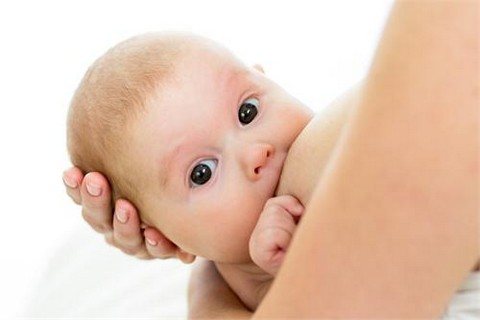
If a baby has diarrhea, the nursing mother should follow a strict diet
Formula-fed children also need to switch to fractional meals. To do this, a single portion of the mixture is halved, and the total number of feedings is increased. Perhaps the doctor will prescribe a medicinal fermented milk mixture for the period of diarrhea. If diarrhea occurs in children receiving complementary foods, it is temporarily removed from the diet and only breast milk or formula is left.
Problems with the gastrointestinal tract cause people a lot of inconvenience. When for some reason an upset stomach occurs, then at that moment it is impossible to think about anything else or do anything. Only a specialist can say for sure how to eat properly during diarrhea and whether it is possible to eat at all, but everyone should know the basics.
Diet No. 4
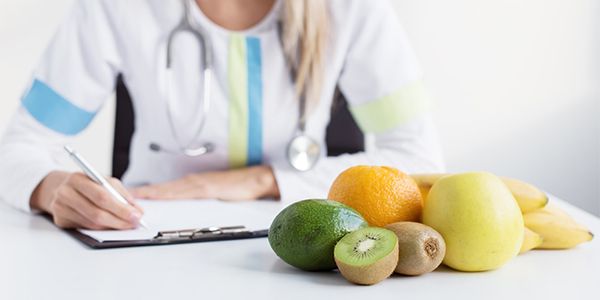
Diet 4 for intestinal diseases with diarrhea, proposed by specialists, is monotonous in its product composition, but does not have everything necessary for the full functioning of the body. Its use should be limited to a period of two days to a week.
You can prepare food only from products approved for consumption. It is necessary to limit the amount of fat and carbohydrate compounds received.
When creating a menu, use the following products:
- dried bread made from wheat flour;
- unsweetened crackers, the recipe of which does not include raisins;
- bagels, drying;
- dietary meat of animals and birds that belong to dietary breeds;
- lean varieties of fish (in this case, dishes must be prepared from minced meat);
- soups;
- porridges cooked on a water basis until the cereals are boiled, you can add a little milk (no more than a third of the amount of liquid);
- pasta;
- a variety of vegetables that can be cooked in water or by stewing without peeling;
- bananas, fruits from our gardens, such as pears or apples, but not fresh, but after cooking in the oven;
- eggs boiled for no more than 10 minutes (soft-boiled);
- an omelette, but not fried in a frying pan, but steamed;
- skim cheese;
- different types of tea brewed in a weak consistency;
- uzvar;
- water;
- fruit jelly.
Diet can cope with the disease without medication in mild cases of diarrhea.
When developing their own menu, some patients completely remove calcium-containing foods from their diet. However, this cannot be allowed. The fact is that during diarrhea a large amount of minerals are washed out of the body, and there is nothing to restore them with. If there is not enough calcium in the body, most organs can be significantly damaged.
Don't think that calcium is only found in dairy products. Even though they are not allowed for consumption during the treatment of diarrhea, they can be replaced with other, no less healthy products. For example, jacket potatoes. This vegetable contains slightly less calcium than cottage cheese. Another source is bananas.
Sometimes you can hear the opinion that salt is also harmful when treating diarrhea. Don't believe such statements because they do more harm than good. Salt is one of the main elements that helps the body retain and absorb moisture. Salty soups are especially useful during treatment for loose stools.
Principles of proper nutrition for diarrhea
If you have diarrhea, you should absolutely not eat fatty foods.
In order to improve the condition qualitatively and as quickly as possible during the period of diarrhea, it is considered necessary to follow a properly selected diet.
In order not to aggravate the problem and to promote a speedy recovery, it is necessary to follow a special diet and diet for diarrhea.
Products that can be consumed during this period should perform an enveloping function in order to create a kind of protective film in the stomach and thereby protect the intestinal walls from irritating factors. You should not eat aggressive foods. It is strictly forbidden to eat:
- too fatty food
- over-salted food
- products that cause fermentation processes
- carbohydrate foods.
To quickly restore the disturbed microflora and to help the digestive organs work normally, it is recommended to follow the rule of drinking plenty of fluids. Health care providers prescribe drinks that help replenish electrolytes. What drinks can you drink if you have diarrhea?
- still mineral water (alkaline);
- natural apple juice;
- decoctions of dried fruits (raisins, dried apricots);
- warm infusion of rosehip or bird cherry;
- teas (strong black with lemon, tea made from raspberry and currant leaves);
- blueberry jelly;
- medical solutions to replenish salts in the body (such as Gastrolit, Regidron).
About proper nutrition for diarrhea - in the thematic video:
As for food, if you have diarrhea, it is highly advisable to eat liquid or semi-liquid food that has “astringent” properties and is rich in beneficial microelements. Experts recommend following diet No. 4, which includes the following foods:
- Rice porridge has a liquid or semi-liquid consistency. Most people know that rice has a so-called “binding effect.” This ability is explained by the fact that rice does not contain fiber, which has a laxative effect.
- Rice decoction. You should drink half a glass of this decoction before your main meal. It is advisable to drink it every two hours, so recovery will be much faster.
- Slimy porridges (buckwheat, oatmeal, semolina).
- Bananas. This beloved fruit is not only delicious, but it is also very rich in potassium, which in turn can perfectly replenish the supply of missing electrolytes lost due to indigestion.
- Boiled carrots or carrot puree. The recommendation to eat carrots is due to the high content of vitamin A in the vegetable, which perfectly restores the mucous membrane of the intestinal walls.
- Dry white bread (bought yesterday or in the form of crackers).
- Boiled and baked apples. It is better to eat it as a puree. The content of a large amount of amino acids in such a dish (such as pectin, tannin) promotes excellent removal of toxins and restoration of intestinal tract microorganisms.
- Lean fish and meat. It is better to cook by steaming; you cannot eat skin and tendons, only clean meat.
- Soups with meat or fish broth (not very fatty).
- Soups with added mucous grains.
- Low-fat, fine-grained cottage cheese and boiled eggs. These foods are rich in essential proteins.
An approximate menu for diarrhea for one day (this menu is only suitable for an adult; there is a different approach to the child’s menu):
- Breakfast 1: oatmeal, black tea with lemon.
- Breakfast 2: blueberry jelly.
- Lunch: soup with rice and boiled fish, buckwheat with water, steamed chicken cutlets, apple juice.
- Afternoon snack: raspberry leaf tea.
- Dinner 1: boiled eggs, raisin broth.
- Dinner 2: pear jelly.
Authorized Products
In the first 2-3 days after the onset of symptoms of an intestinal disorder, the most gentle diet is required, which includes the following products:
Rice soup with water, lightly salted - rice strengthens well and also coats the intestinal walls, helping to reduce irritation. Steam omelette contains a large amount of protein, which the body needs during the rehabilitation period. Unsweetened rye crackers, bagels, biscuits.
For drinking, in addition to boiled or mineral water, you should consume drinks and decoctions of those products that contain a high content of tannins. These include:
strong large-leaf black tea; blackcurrant compote; rosehip decoction; compote of rowan and dogwood.
In the following days, the following dishes are gradually introduced:
jelly; steamed meat cutlets from chicken, turkey or rabbit; steamed fish of low-fat varieties; vegetable soup with meat broth; low-fat cottage cheese and sour cream, yogurt, kefir and cheese; apples baked in the oven.
Maintaining a normal diet is possible no earlier than after 10-12 days of no signs of diarrhea.
Feeding a child with diarrhea
If a child has diarrhea, you need to give him mixtures with an increased level of bifidobacteria.
Breastfed baby. If a mother feeds her baby only breast milk, then nothing should change in the child’s diet, since nature has made sure that mother’s milk contains all the important and necessary microelements that will help the child’s body recover quickly. But still, it is better for the mother herself to refrain from provoking foods and watch her diet.
A child is bottle-fed. Children fed with adapted formulas need additional help for the body, because no matter how high-quality and highly adapted the formula is, it does not contain the entire set of necessary microelements.
At the time of diarrhea, you need to give the baby mixtures with a high content of bifidobacteria, give him plenty to drink (you can use pharmaceutical solutions: Regidron, Oralit; you can use solutions prepared at home).
The child is over one and a half years old. In the beginning, it is necessary to feed the child warm, porridge-like soups with mucous grains. The food must be homogeneous and warm so as not to provoke a worsening of the condition.
When your little body begins to recover, you can slowly begin to introduce steamed dishes made from lean fish or lean meat (finely chopped).
These recommendations on proper nutrition for diarrhea in children and adults are relevant, but still, for greater confidence, it is better to contact your family doctor, he will draw up a recovery plan based on the individual symptoms and characteristics of the patient.
Prohibited Products
Among the most dangerous products that have a detrimental effect on the gastrointestinal tract are the following:
all fried and fatty foods - increased cholesterol content puts additional stress not only on the liver, but also on the intestines; sweet baked goods - high sugar content leads to fermentation processes, which aggravates diarrhea; pearl barley and barley porridge - contain a large amount of fiber, the absorption of which requires some effort from the gastrointestinal tract; sausages, canned food and any dishes containing dyes and preservatives; mushrooms and seafood; fish with a high content of salts and fats; Red caviar; chips, crackers and other beer snacks; corn sticks, flakes, sweet confectionery; jams and pickles; all legumes and nuts; fresh vegetables, especially onions, garlic, cabbage, peas and bell peppers; alcoholic drinks and sweet carbonated drinks.
All these products have a complex composition, so it is better to avoid them during the rehabilitation period after suffering from diarrhea.
Diarrhea in women who are breastfeeding
Diarrhea during breastfeeding is often associated with stress.
As you know, diarrhea in a nursing mother is often associated with stress, in such a situation you shouldn’t worry too much, you need to try to ensure a calm environment and everything will fall into place.
But if mucous or bloody discharge is found in a woman’s stool, she feels nauseous or vomits, then you should sound the alarm; perhaps an upset stomach is caused by an infectious disease.
You will probably have to stop feeding your baby breast milk, as the baby may also “catch” the disease. If there is no danger, then there is no need to stop breastfeeding, you just need to reconsider your diet, give preference to steamed dishes and temporarily stop eating vegetables, fruits, sweets, baked goods, spices and other foods that irritate the intestines.
Causes of diarrhea
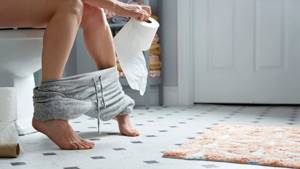
Diarrhea occurs for various reasons. It usually occurs due to poor diet, poisoning of the body and some infectious diseases that affect the condition of the intestines.
Most often, a diet for upset stomach and intestines is prescribed depending on the cause of loose stools. Here are the main reasons that cause diarrhea:
- heavy food, overeating. It most often causes diarrhea;
- consumption of vegetables, soups, liquid foods, dried fruits, such as dried apricots or prunes;
- individual intolerance to some components;
- bowel irritation;
- mild food poisoning;
- intestinal dysbiosis;
- pancreatitis;
- use of sweeteners;
- use of medications and laxatives;
- gastritis and intestinal diseases;
- stomach ulcer due to Helicobacter pylori bacteria;
- in women – pregnancy, premenstrual syndrome and hormonal imbalance;
- poor quality and irregular food;
- severe degree of toxin poisoning.
If diarrhea is not caused by acute poisoning or intestinal diseases, then with proper nutrition it passes quickly, without causing additional unpleasant symptoms.
Diet after diarrhea
After diarrhea, you can gradually include lean meat and fish products in your diet.
In order for the body to fully recover from diarrhea, you need to maintain a loyal diet for some time, gradually including lean meat and fish products, steamed and finely chopped.
Diarrhea can occur due to ingestion of a poor quality or stale product. Usually diarrhea begins 2-3 hours after eating such food.
There is no need to panic, you should drink as much fluid as possible and everything will be resolved safely soon. If the problem does not go away, then the right thing to do is contact your doctor.
Now the basic principles of treating diarrhea are clear, but it is worth remembering that everything must be done in moderation, and excessive consumption of “fastening” and “astringent” products can lead to the reverse process and diarrhea will be replaced by intestinal constipation.
Diet after diarrhea in adults is part of complex therapy for the main ailment that provoked indigestion.
A diet after diarrhea is necessary to reduce the negative manifestations of this phenomenon and speedy recovery of the patient.

Folk remedies for the treatment of diarrhea

Rice water - probably many have heard about such a popular remedy for diarrhea as rice water.
This drink is much more effective than many advertised tablets and does not cause any harm to the body. And, if we are talking about the advantages, then it is impossible not to mention that this remedy saturates the body well with useful substances that are so necessary during diarrhea.
Principles of nutrition
A diet after diarrhea in an adult consists of following some rules according to which the intestinal microflora can be normalized.
The basic rules include recommendations regarding food and how to eat it:
- thorough hand washing;
- use only clean dishes.
After diarrhea, an adult patient is not recommended to visit cafes and other catering establishments, as the quality of food may vary. At the same time, the gastrointestinal tract organs may react negatively to it.
A diet after diarrhea in an adult patient and a child requires the use of only high-quality products in the cooking process.
Expired fermented milk products are contraindicated. If you eat them, you can cause fermentation, causing a relapse of poisoning, diarrhea, and vomiting.
The danger of such a clinic for adults and children is dehydration. Therefore, patients’ efforts will be aimed at restoring water balance. The post-diarrhea diet should be prescribed by a qualified physician.
Meals should include greens and vegetables with fruits. In this case, possible products are doused with boiling water. This preventive measure will protect the adult patient from relapse of diarrhea.
If this rule is ignored, the treatment that the patient has already undergone will not be effective.
Healthy food
If adults have an appetite after diarrhea, they are on the mend. The intestines after an illness are prone to pathological conditions.
The heavy load exerted by poor nutrition only harms it. Immediately after acute diarrhea, you can eat crackers with unsweetened tea. Food for adults and children should be gentle and fortified.
During and after food poisoning, you can eat small meals, but often. Food is consumed 5-6 times a day, little by little. This diet normalizes the functioning of the intestines.
To satisfy your hunger, you can eat biscuits, crackers without sugar and salt. It is more difficult to choose nutrition for patients whose intestinal upset is accompanied by vomiting.
During illness, the body loses many nutrients. A weakened patient needs specialized nutrition.
To prevent exhaustion, the doctor selects a diet that can help replenish lost vitamins, minerals and proteins in a short period.
After diarrhea without vomiting, you can eat:
- yesterday's white bread;
- low-fat soups prepared with decoctions of various cereals. They add carrots, cauliflower;
- lean meat is a good source of nutritious protein;
- steamed curd soufflé;
- steam omelette.
After diarrhea, you can eat fiber, which is found in fresh bananas and baked apples. The diet includes steaming various cereals.
If the food prescribed by the doctor provokes vomiting, you cannot be treated with folk remedies.
In such cases, drinking vodka with pepper is contraindicated. This drink will increase intestinal irritation, which will lead to intoxication.
Vodka disrupts the functions of the gastrointestinal tract to a greater extent. In this case, the current illness will worsen, and diarrhea will resume.
What is diarrhea
Diarrhea (colloquially called diarrhea) is a change in the appropriate consistency of stool.
Although this pathology is common (3-5% of the population), there are a lot of concomitant diseases for differential diagnosis, their sum reaches several hundred nosologies.
There are three types of diarrhea: liquid, fatty (malabsorption) and inflammatory etiology (with the presence of blood and pus in the stool).
However, not all cases of diarrhea strictly fit into these categories - there are combined cases. Liquid diarrhea is divided into osmotic (water retention due to poor absorption of nutrients), secretory (decreased water absorption) and functional (intestinal hyperkinesia).
A syndrome characterized by the acute development of watery diarrhea without blood (three or more loose stools per day).
Contraindicated foods
In case of food poisoning and after it, diet No. 4 is indicated. To fully restore the body, it is recommended to give up irritating, mechanically rough and heavy foods.
Nutrition should not burden the gastrointestinal tract with low-quality products. Sometimes a picture is observed when the patient fasts for a long period, while he has no appetite. Such patients can and should drink a lot of fluids.
To do this, cook compote or jelly from berries. You can brew weak tea. Before taking, the compote and decoction are filtered so that small particles from the berries do not enter the gastrointestinal tract.
The diet after diarrhea prohibits eating fresh fruits and vegetables, canned food, spices, and baked goods.
The post-diarrhea diet does not include the consumption of any concentrated acidic juices. Such drinks negatively affect the walls of the stomach and intestines.
You cannot add spices to food. They also provoke irritation of the intestinal mucosa.
Against the background of such treatment, the patient’s poor condition can only worsen. It is more difficult to select a diet for patients with irritable bowel syndrome. It is forbidden to drink yogurt and milk, or eat cottage cheese.
How long to follow the diet?
In the case where diarrhea developed against the background of the harmful effects of antibiotics, the diet should be followed exactly until the doctor diagnoses complete recovery and disappearance of dysbiosis. On average, for a child it is 10-12 days, for an adult it is 5-7 days. If diarrhea had more serious causes, and was also complicated by vomiting, fever and chills, the diet should be followed until complete recovery (10-15 days).
It is important to wait at least 10 days, since this is the amount of time it will take to completely restore the intestinal microflora, which will enable its full functioning.
Otherwise, there is a risk of developing complications, as well as chronic irritable bowel syndrome.
Allowed drinks
Diet after diarrhea includes drinking plenty of fluids. This is necessary to restore water balance in the body. Scientists have proven that a diet that includes all drinks is ineffective after diarrhea.
Patients who have recovered from loose stools must adhere to a certain drinking regime.
Frequent coffee consumption disrupts the functioning of the genitourinary system. This is due to the fact that this drink has a diuretic effect.
The patient should forget about coffee for several weeks. You can replace it with a decoction of herbs and green tea.
The diet allows you to brew rose hips, which are rich in many vitamins. You can brew chamomile or another sedative.
The diet allows you to make homemade jelly from dogwood and blueberries. To prepare it, you can use sugar in small quantities.
After diarrhea, you need to brew blueberry and chamomile tea. This drink has a healing and strengthening effect, which has a positive effect on the subsequent functioning of the gastrointestinal tract. The patient should return to a normal diet gradually.
After diarrhea caused by food poisoning, the diet is followed for 2-4 weeks. If necessary, dietary table No. 4 is prescribed for a few more days.
Replacing light foods with heavy foods should be simple and only under the supervision of a doctor.
The menu is initially changed for breakfast, then for lunch and dinner. The diet should only be adjusted by a nutritionist with a gastroenterologist.
To support the intestinal microflora during the period when a diet is indicated, you can drink the drug Sorbex. It is prescribed for food poisoning and other dangerous phenomena that cause diarrhea, vomiting, and fever.
Infectious disease specialists and pediatricians advise following the rules of hygiene from early childhood. This will prevent intestinal upset in the future.
Chronic and acute intestinal disorder
The diet is prescribed taking into account the type of diarrhea:
- acute – develops against the background of a parasitic viral or bacterial infection of the intestine. This condition can also be provoked by drinking contaminated water. A similar clinic is typical for stress and food intolerance;
- chronic - associated with colon ulcers, Crohn's disease, ulcerative colitis and other chronic diseases, as well as inflammation.
In the two cases discussed above, the same symptoms are observed:
- Frequent bowel movements.
- Nausea.
- Sharp or constant pain in the abdomen.
- Dehydration.
A strong manifestation of gastrointestinal disorder is blood in the stool, temperature above 38 degrees, and vomiting. In such a clinic, diet No. 4 is accompanied by drug treatment.
The advantages of the dietary table in question include:
- normalization of intestinal function;
- improvement of microflora and functions of the digestive system;
- restoration of water and salt balance.
Scientists have proven that after diarrhea it is better to eat the following foods:
- mashed cottage cheese;
- hard-boiled egg;
- soup and broth with fish or meat;
- bran bread, pre-dried;
- lean beef meatballs;
- fresh carrots, grated or carrot puree, prepared using a blender;
- rice water;
- quince jelly.
Scientists have also identified foods that are prohibited after diarrhea. They should not be included in the diet during the period of recovery of the body after an illness.
This list includes:
- fresh berries;
- gray and black bread;
- pickles, marinades, smoked meats;
- fatty food;
- mushrooms;
- all legumes;
- sauces and spices;
- juices and syrups.
Diet No. 4 has no disadvantages or contraindications.
But since the diet in question is therapeutic, and it is aimed at preventing relapse and restoring the gastrointestinal tract after diarrhea, it cannot be followed in order to reduce your weight.
Advice from nutritionists and gastroenterologists
After diarrhea, you need to eat small and often. At the same time, it is recommended to drink plenty of fluids. The norm for each dish in the dietary table should be 250 g/ml.
For an adult patient who has had diarrhea, the following menu is approximately prescribed:
- in the morning you need to prepare a steam omelette, eat 50 grams of bread, drink rice water;
- Chicken broth with croutons is prepared for lunch;
- For lunch you are allowed to prepare soup with rice and beef meatballs. The patient can also eat 50 grams of bread, drink black tea;
- afternoon snack – several baked apples;
- dinner – mashed potatoes with eggs and jelly;
- late evening - bird cherry decoction.
It is more difficult for pregnant women to follow a diet after diarrhea. This category of patients is at risk and requires increased attention from all physicians.
Pregnant women after diarrhea are prescribed the following diet:
- in the first 2 days after restoration of the functioning of the gastrointestinal tract, it is recommended to eat rice or oatmeal porridge cooked in water. You can bake apples, brew a decoction of rice or bird cherry;
- if the symptoms of diarrhea have decreased, you can introduce crackers and weak tea into the diet;
- For complete recovery, lenten soup and boiled meat are introduced.
With colitis, diarrhea or constipation often appears and bothers the abdominal area. Colitis accompanied by diarrhea requires the patient to adhere to the dietary table:
- steam omelette;
- dietary grade of fish and meat;
- puree from various vegetables;
- baked apple or pear;
- berry, rice, herbal decoction.
If diarrhea is accompanied by vomiting, on the first day of the diet table it is recommended to eat food consisting of an astringent liquid. Rice water, infusion of bird cherry or incense, and black tea have this effect.
In the following days you need to adhere to the following table:
- In the morning the patient prepares mashed potatoes and drinks rice water;
- chicken broth is prepared for lunch;
- For lunch, jelly from berries and thin oatmeal porridge are prepared;
- for an afternoon snack you can bake an apple, steam a solution of bird cherry;
- in the evening prepare chicken broth and carrot puree;
- Semolina and tea are prepared at night.
If diarrhea is caused by antibiotic therapy, the intestinal microflora is disrupted.
To prevent dysbiosis during this therapy, you need to take drugs that normalize and restore intestinal microflora.
At the same time, it is recommended to follow a dietary table, adhering to the following advice from nutritionists and gastroenterologists:
- On the first day, omelette and rice porridge are prepared in a double boiler. You can brew a decoction, prepare jelly from berries;
- from the third to the fifth day, you can cook steamed meatballs and cutlets, and brew herbal tea.
In case of acute intestinal disorder, gentle nutrition is provided. The patient is allowed to eat foods that reduce the symptoms of acute diarrhea:
- banana, baked apples or applesauce;
- mashed potatoes;
- White rice;
- toast, crackers, sugar-free cookies;
- chicken;
- blueberries with bird cherry;
- yogurt;
- Herb tea.
In acute and chronic forms of diarrhea, nutrition is no different.
In this case, chronic intestinal disorder is accompanied by poor absorption of minerals and vitamins, including phosphorus, potassium, magnesium. Therefore, the diet is aimed at introducing cheese, apples, and quince into the diet.
With chronic diarrhea, you need to constantly eat properly to prevent relapse:
- In the morning, viscous porridge with butter is eaten, cottage cheese is pureed, and jelly is drunk;
- for lunch you can drink rice water and eat crackers;
- for lunch they prepare jelly and make beef cutlets;
- You can bake pears for an afternoon snack;
- For dinner, semolina porridge based on chicken broth is cooked.
The benefits of a diet table for intestinal disorders
The effectiveness of the above products in eliminating diarrhea has been clinically proven. For mild, moderate and severe cases, diet therapy is indicated. Its basis is a plentiful drinking regimen.
If diarrhea is accompanied by vomiting, and it is impossible to put in a drip with saline solution, then it is taken orally, but in small portions.
In order not to provoke another vomiting, take 1 tsp of the solution. every 30 seconds.
You can replace it with mineral water, but without gases. The secondary basis of the table in question is frequent and small portions. In this case, the gastrointestinal tract is not overloaded, and pain decreases at the same time.
According to this diet, foods that provoke intestinal inflammation are excluded from the diet, as well as those dishes that burden the liver, kidneys, and pancreas.
Due to dietary restrictions, the patient is able to cure himself. The dietary table consolidates the results of the therapy, helping the body recover.
Symptoms of the disease
Diarrhea begins with increasing abdominal pain, followed by frequent loose stools. With frequent bowel movements, the anus becomes irritated and a painful burning sensation occurs. If the diarrhea has an infectious beginning, then the temperature and headache rise. Any diarrhea is, first of all, a leaching of useful minerals and vitamins from the body. As a result, weakness, dizziness, and even heart failure occur.


